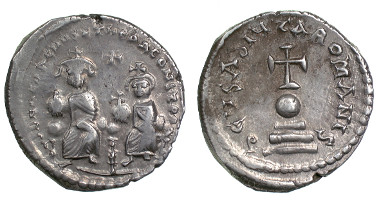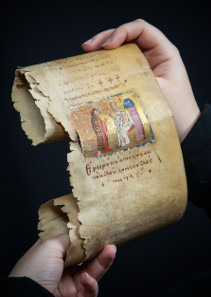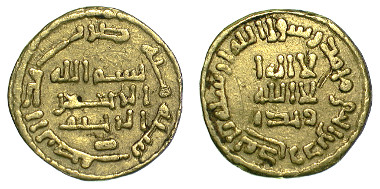February 13, 2014 – The relationship between religion and money in two of the world’s major faiths, at a pivotal time in their early history, is explored in Faith and Fortune, a new exhibition at the University of Birmingham’s Barber Institute of Fine Arts. The display runs until November 30, 2014.
Silver hexagram of Herakleios, minted in Constantinople 613-620. © The Trustees of the Barber Institute of Fine Arts, University of Birmingham.
In the first quarter of the seventh century, a time of grave crisis for the Byzantine or East Roman Empire, the Emperor Herakleios requisitioned silver from the churches of Constantinople to pay his army. The coins bore the legend ‘God Help the Romans’. Prior to this, in AD 608, Herakleios and his army had travelled from Carthage to Constantinople to topple the previous Emperor Phokas – taking control of the mints of Israel and Cyprus en route. They produced new coins with Herakleios’s own image on them – establishing his credentials as an emperor-in-waiting rather than just a rebel.
A generation later, rejecting the Byzantine use of imperial and divine images on coins, the leader of the first Muslim Empire, the Umayyad Caliph Abd Al-Malik, created a coinage emblazoned with Islamic verse, which set the standard for Muslim coinage for centuries.
Prayer Scroll of Princess Eudokia. © John James.
This fascinating exhibition explores the designs and manufacture of coinage in the neighbouring Byzantine and early Muslim empires. The relationship between these two states was characterised by a constant dialogue of trade, intellectual exchange and military confrontation. These coins and other artefacts show how currency was used by each to assert cultural difference by its iconography, at the same time promoting each culture’s concept of the divine. The developing dialogue of Muslim and Christian responses to divine images and divine word on coinage is also picked up at a later date in a cabinet showcasing the Barber’s remarkable collection of 12th-century Artuqid coins. Using a mixture of Christian imagery and Islamic sacred verse, these coins from the area of modern Turkey demonstrate the long-term historical impact of events in the 7th and 8th centuries.
Featuring some 80 coins from the Barber Institute’s world-leading collection of Byzantine coins and fine caches of Roman, medieval and Islamic coins, it also features loans of objects from other public and private collections in Birmingham.
Gold half-dinar of Umar II, minting location unknown, minted 718/19. © The Trustees of the Barber Institute of Fine Arts, University of Birmingham.
These include some very early editions of the Qur’an, as well as a beautiful and very rare 13th-century illuminated prayer scroll, commissioned by the Byzantine Princess Eudokia Doukas, displayed here in public for the first time since its recent discovery.
The exhibition’s curator, Rebecca Darley, said: ‘While this exhibition focuses on currency, religion and culture in a precise and limited period of history – Byzantium in the fifth to eighth centuries – the resonances in recent history are quite remarkable.
‘After the first Gulf war, for example, the government of Iraq used a Chinese printer to supply its currency due to UN embargo preventing it from meeting the needs of its population from other sources. In an example of the continued relevance of the themes explored in this exhibition, these emergency banknotes printed in China in 1990 for the Iraqi state carried on them an image of a gold coin almost identical to that of Abd Al-Malik on display at the Barber Institute, minted by the Abbasids (the direct successors of the Umayyad Caliphs).
‘We hope this exhibition will illustrate how the everyday currencies of these early Islamic and Christian empires reflected their own political identities, cultures and faiths, in a highly comparable way to how the small change in our own pockets is a reflection of our own culture and society.’
Faith and Fortune will be complemented by a varied programme of related events, including fascinating public lectures and gallery talks, and enjoyable and educational practical workshops for all ages.
For more information on the exhibition or if you want to visit the display, please consult the museum’s website.







